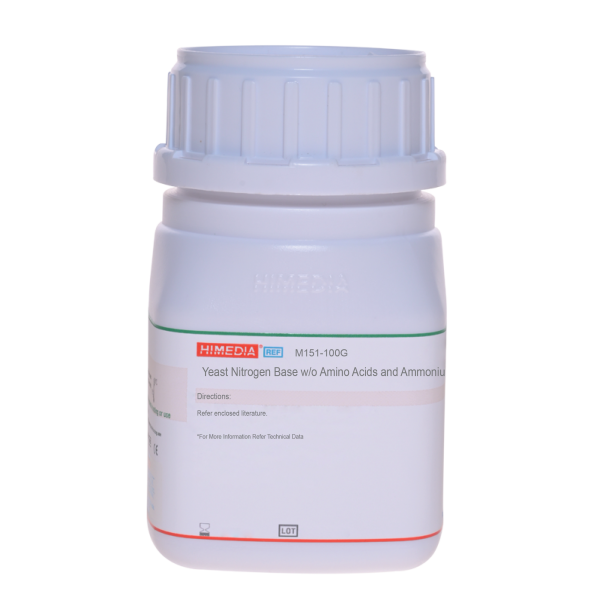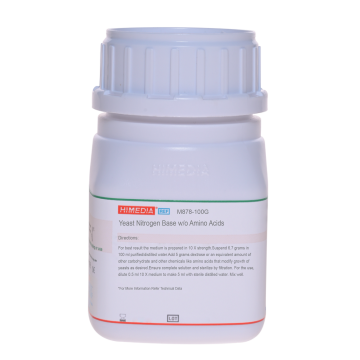 Your enquiry has been submitted
Your enquiry has been submitted
Yeast Nitrogen Base w/o Amino Acids and Ammonium Sulphate
Intended use
Yeast Nitrogen Base without Amino Acids and Ammonium Sulphate is recommended for use in the classification of yeasts on the basis of their ability to assimilate nitrogen and carbon compounds.
Composition**
| Ingredients | Gms / Litre |
|---|---|
| Biotin | 0.000002 |
| Calcium pantothenate | 0.0004 |
| Folic acid | 0.000002 |
| Inositol | 0.002 |
| Niacin | 0.0004 |
| p-Amino benzoic acid (PABA) | 0.0002 |
| Pyridoxine hydrochloride | 0.0004 |
| Riboflavin (Vitamin B2) | 0.0002 |
| Thiamine hydrochloride | 0.0004 |
| Boric acid | 0.0005 |
| Copper sulphate | 0.00004 |
| Potassium iodide | 0.0001 |
| Ferric chloride | 0.0002 |
| Manganese sulphate | 0.0004 |
| Sodium molybdate | 0.0002 |
| Zinc sulphate | 0.0004 |
| Potassium dihydrogen phosphate | 1.000 |
| Magnesium sulphate | 0.500 |
| Sodium chloride | 0.100 |
| Calcium chloride | 0.100 |
Final pH ( at 25°C) 4.5±0.2
**Formula adjusted, standardized to suit performance parameters
Directions
A. For Carbon Assimilation tests, prepare the broth base in 10X concentration. Dissolve 1.7 grams in 100 ml purified/ distilled water. Add 5 grams ammonium sulphate, 10 mg L-histidine, 20 mg DL-methionine and 20 mg DL-tryptophan. Carbon compounds for assimilation test are added in 10X concentration singly or in combination as required.
B. For Nitrogen Assimilation tests, prepare the medium in 10X concentration. Dissolve 1.7 grams in 100 ml distilled water. Add 1 gram dextrose, 1 mg L-histidine, 2 mg DL-methionine and 2 mg DL-tryptophan. Add nitrogen compounds for assimilation test in 10X concentration singly or in combination as required. Wickerham employed the following nitrogen sources : ammonium sulphate 1gm, potassium nitrate 0.78 gm, urea 0.46 gm, asparagine 1 gm, peptone (gelatin) 1.32 gms. For A and B, filter sterilize the 10X strength solution. Refrigerate and use as needed. Prepare final medium by aseptically pipetting 0.5 ml of the 10X sterile medium into 4.5 ml sterile distilled water. Mix well.
Principle And Interpretation
Yeast Nitrogen Base without Amino Acids and Ammonium Sulphate is used for classifying yeasts based on carbohydrate and amino acids requirements. This medium lacks the amino acids, histidine, methionine and tryptophan and also ammonium sulphate. Yeast Nitrogen Base is prepared as per the formulations of Guenter (3), which in turn is modification of Wickerham's formulation (7). Yeast Nitrogen Base without Amino Acids and Ammonium Sulphate contains essential nutrients and vitamins necessary for cultivation of yeasts, except amino acids and a source of nitrogen and carbohydrates. Wickerham used the following nitrogen sources - ammonium sulphate 1.0 gm/l, potassium nitrate 0.78 gm/l, urea 0.46 gm/l, asparagine 1.0 gm/l, peptone (gelatin) 1.32 gm/l. Yeasts grown on rich medium may carry a reserve of nitrogen in the form of proteins that may result in erroneous findings. To avoid this, 2 serial transfers in complete medium are recommended. After sufficient incubation, measure the growth turbidimetrically at 660 nm using spectrophotometer and compare with control.
Type of specimen
Food Samples.
Specimen Collection and Handling
For food samples, follow appropriate techniques for sample collection and processing as per guidelines (1,5,6). After use, contaminated materials must be sterilized by autoclaving before discarding.
Warning and Precautions
Read the label before opening the container. Wear protective gloves/protective clothing/eye protection/ face protection. Follow good microbiological lab practices while handling specimens and culture. Standard precautions as per established guidelines should be followed while handling specimens. Safety guidelines may be referred in individual safety data sheets.
Limitations
- Further biochemical tests must be carried out for confirmation.
Performance and Evaluation
Performance of the medium is expected when used as per the direction on the label within the expiry period when stored at recommended temperature.
Quality Control
Appearance White to cream homogeneous free flowing powder
Colour and Clarity of prepared medium Colourless (at 10X concentration colour of medium is pale yellow) clear solution without any precipitate.
Reaction Reaction of 0.17% w/v aqueous solution at 25°C. pH : 4.5±0.2
Cultural Response Cultural characteristics observed after an incubation at 35-37°C for 6-7 days.
| Organism | Growth (Plain) | Growth w/ additions |
|---|---|---|
| Kloeckera apiculata ATCC 9774 | none-poor | good |
| Saccharomyces cerevisiae ATCC 9763 (00053*) | none-poor | good |
| Saccharomyces uvarum ATCC 28098 | none-poor | good |
Key * : Corresponding WDCM Numbers
Storage and Shelf Life
Store between dehydrated and the prepared medium at 2-8°C. Use before expiry date on the label. On opening, product should be properly stored dry, after tightly capping the bottle in order to prevent lump formation due to the hygroscopic nature of the product. Improper storage of the product may lead to lump formation. Store in dry ventilated area protected from extremes of temperature and sources of ignition Seal the container tightly after use. Use before expiry date on the label.
Product performance is best if used within stated expiry period.
Disposal
User must ensure safe disposal by autoclaving and/or incineration of used or unusable preparations of this product. Follow established laboratory procedures in disposing of infectious materials and material that comes into contact with sample must be decontaminated and disposed of in accordance with current laboratory techniques (3,4).
Reference
- American Public Health Association, Standard Methods for the Examination of Dairy Products, 1978, 14th Ed., Washington D.C.
- Guenter, Personal communication.
- Isenberg, H.D. Clinical Microbiology Procedures Handbook. 2nd Edition.
- Jorgensen, J.H., Pfaller , M.A., Carroll, K.C., Funke, G., Landry, M.L., Richter, S.S and Warnock., D.W. (2015) Manual of Clinical Microbiology, 11th Edition. Vol. 1.
- Salfinger Y., and Tortorello M.L. Fifth (Ed.), 2015, Compendium of Methods for the Microbiological Examination of Foods, 5th Ed., American Public Health Association, Washington, D.C.
- Wehr H. M. and Frank J. H., 2004, Standard Methods for the Microbiological Examination of Dairy Products, 17th Ed., APHA Inc., Washington, D.C.
- Wickerham L. J., 1951, U.S. Dept. Agric. Tech. Bull No. 1029.
| Product Name | Yeast Nitrogen Base w/o Amino Acids and Ammonium Sulphate |
|---|---|
| SKU | M151 |
| Product Type | Regular |
| Physical Form | Powder |
| Origin | Chemically defined (HiCynth™) |
| Packaging type | HDPE |
| References | 1. Guenter, Personal communication. 2.Wickerham L. J., 1951, U.S. Dept. Agric. Tech. Bull No. 1029. 3.Isenberg, H.D. Clinical Microbiology Procedures Handbook. 2nd Edition. 4.Jorgensen,J.H., Pfaller , M.A., Carroll, K.C., Funke, G., Landry, M.L., Richter, S.S and Warnock., D.W. (2015)Manual of Clinical Microbiology, 11th Edition. Vol. 1. 5.American Public Health Association, Standard Methods for the Examination of Dairy Products, 1978, 14th Ed., Washington D.C. 6.Salfinger Y., and Tortorello M.L. Fifth (Ed.), 2015, Compendium of Methods for the Microbiological Examination of Foods, 5th Ed., American Public Health Association, Washington, D.C. 7.Wehr H. M. and Frank J. H., 2004, Standard Methods for the Microbiological Examination of Dairy Products, 17th Ed.,APHA Inc., Washington, D.C. |
| Customized Product Available | No |






